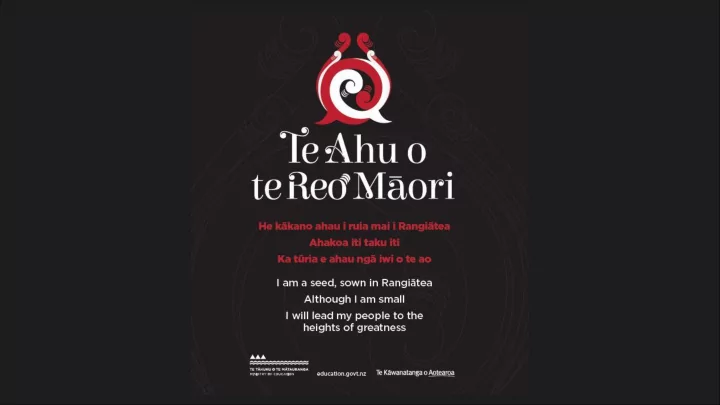

Te Ahu o te Reo M āori demonstrates a strong commitment by Government to: • Strengthen its commitment to Te Tiriti o Waitangi, supporting te reo Māori revitalisation efforts and productive partnerships. • Strengthen and grow an education workforce that can integrate te reo Māori into the learning of all ākonga in Aotearoa New Zealand by 2025.
A co-design approach Te Ahu o te Reo Māori is a Ministry -lead initiative that was co-designed with te reo and mātauranga Māori experts, upon common principles and aspirations for the revitalisation and growth of te reo Māori in education.
Key objectives of this kaupapa are to: • Lift the capability of our education workforce (from early learning through to secondary school) to use te reo Māori correctly every day. For those who choose to teach te reo Māori they will have the capability to deliver quality te reo Māori. • Provide opportunities for all learning environments to create and nurture safe opportunities for all staff and ākonga to normalise the use of te reo Māori every day.
Key objectives - continued • Te Ahu o te Reo Māori will target those in the workforce that have no reo Māori capability and who are keen to learn, through to those who are confident te reo Māori speakers but need professional support to lift their fluency.
Ngā Taumata o Te Ahu o te Reo Māori : • Te Ahu o te Reo Māori is supported by Ngā Taumata o Te Ahu o te Reo Māori – a te reo Māori competency framework . • The framework has five levels of learning outcomes (Taumata) and five focus areas, each with appropriate success indicators. Focus areas include local dialect , use , grammar , curriculum and revitalisation . • A key focus of Ngā Taumata is to contextualise learning within classroom and education settings.
As a result of this programme, we will see the following changes overtime: • Normalisation of te reo Māori usage at school and home . • Increase in the quality of te reo Māori used by teachers and students . • Increase in ākonga uptake of te reo Māori learning at school and in the community . • Increase in workforce accessing te reo Māori professional learning development opportunities. • An attitude shift in the wider education community that te reo Māori is recognised as being for everyone.
We must continue to achieve systemic change across the education system so it directly supports the growth of reo Māori and mātauranga Māori, and is increasingly bilingual and bicultural. Te Ahu o te reo Māori provides opportunities for ākonga , whānau and communities to work together to grow and strengthen te reo and mātauranga Māori in education.
Kapiti Horowhenua – Kāuru Education Group • 147 participants from Wellington central, the Hutt Valley, Porirua, Kapiti coast and Horowhenua. Taumata 1-4. • 17 week duration (starting 15 July 2019), 91 hours per student. • A blended learning approach including: 12 weekly 2 hour classes; one rumaki kura reo (4 days); three weekly 30 minute book and online self-directed learning lessons. • Content is based around local reo, local traditions, values and history and includes learning via karakia, waiata and haka. • Delivery is focused on enabling participants to demonstrate kaitiakitanga, manaakitanga and whanaungatanga.
Taiuru (Taranaki/ Whanganui) – Te Ataarangi ki Taranaki Charitable Trust • 97 participants from Taranaki and Whanganui. Taumata 1-2. • 16 week duration (starting 8 May 2019), 126 hours per student. • Based on Te Ataarangi immersion approach including: three Noho Rumaki (3 days); weekly Kura Pō (2 hours, excluding Noho Rumaki weeks); weekly 30 online learning and challenges (1 hour). • Immersion approach is used to build spontaneity of response in order for reo use to be normalised in the classroom.
Te Waipounamu – Te Rūnanga o Ngāi Tahu • 235 participants from 10 rōpū between Kaikōura and Invercargill. Between 16-40 participants per rōpū . • 15 week duration (starting 8 June 2019), 60 hours per student. • Two different iterations (Tauira): o Tauira 1 - Three Immersion noho (2 days each); One wānanga (1 day). o Tauira 2 - Two wānanga (1 day each); Weekly 3 hour night classes. • Some self-directed learning depending on the kaiako and what has or has not been achieved in class. • Marae are used as delivery sites to help enable the delivery of local dialect, iwi kōrero and tikanga.
Waikato – TupuOra Educaton & Development Limited 166 participants from Rekamauroa (Te Porotaka Namatahi – from Mōkau to Tāmaki , Hauraki across to Kāwhia and inland towards Waikato, Maniapoto and Raukawa). • 11 week duration (two seprate iterations, July-September and October-December 2019), 126.5 hours per student. • Each participant to attend 2 x Kura Whakahihiri (a 3 day seminar/ symposium) and 5 x Akoranga Whakahihiri (full day lessons from 8.30am-3.30pm). • Content is based around Waikato/Tainui dialect, Te Kīngitanga , local history and traditions .
Recommend
More recommend